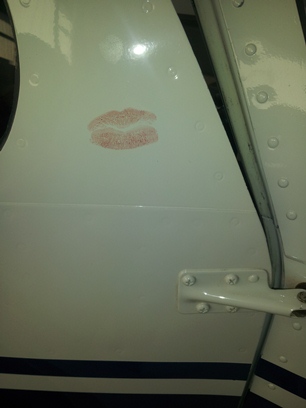kimberlyanne546
Final Approach
As some of you know, I'm no airplane mechanic, but I sometimes play one on the weekends.
This past weekend, both Saturday and Sunday, I got to work many hours on two annuals. The annual inspection of a Cessna and the annual inspection of a Piper.
Though under the supervision of an IA at all times and rarely given more than a simple Phillips screw driver to put back together what seemed like endless numbers of inpection panels, strut covers, and wheel pants, I still had a good time.
And no, I do not get paid to do this. Think of the old days when a kid could just show up and help out at the airport.
I swept a hangar floor, cleaned the bugs off a plane, got to see the timing of magnetos being tested, got to watch an air filter being replaced, a "trim worm" being replaced, and learned about machine metal screws vs. sheet metal screws.
I broke a nail, lost a ton of hair to the creeper, banged my head hard on a wing strut, and my hand appparently got cut a bit on a knuckle. I accidentally had avgas poured into my shoe while they were refueling the plane, and stupidly stood downwind of some cleaning chemicals as they were being sprayed onto a rag.
I learned about metal gas tanks and replacement gaskets and anti-corrosion spray. I learned what a duck bill is, how many twists per inch the safety wire twistey thing is supposed to turn, and I still refused to quit calling rivets "the nubbins."
It was awesome.
I found all kinds of things to make fun of (funny names of parts).
We all had a great time, and of course, shared a beer at the end of the day and told pilot stories (many of the mechanics there are pilots).
Kimberly
PS - This reminds me I am overdue for the "cessna diamond injury". I already bruised my shin on the step up (located on the wing strut of most Skyhawks - used for loading passengers), and now I've hit my head on a wing strug while getting up from a creeper. All that's left is those darned ailerons. Good thing I'm short enough to walk under most wings.
This past weekend, both Saturday and Sunday, I got to work many hours on two annuals. The annual inspection of a Cessna and the annual inspection of a Piper.
Though under the supervision of an IA at all times and rarely given more than a simple Phillips screw driver to put back together what seemed like endless numbers of inpection panels, strut covers, and wheel pants, I still had a good time.
And no, I do not get paid to do this. Think of the old days when a kid could just show up and help out at the airport.
I swept a hangar floor, cleaned the bugs off a plane, got to see the timing of magnetos being tested, got to watch an air filter being replaced, a "trim worm" being replaced, and learned about machine metal screws vs. sheet metal screws.
I broke a nail, lost a ton of hair to the creeper, banged my head hard on a wing strut, and my hand appparently got cut a bit on a knuckle. I accidentally had avgas poured into my shoe while they were refueling the plane, and stupidly stood downwind of some cleaning chemicals as they were being sprayed onto a rag.
I learned about metal gas tanks and replacement gaskets and anti-corrosion spray. I learned what a duck bill is, how many twists per inch the safety wire twistey thing is supposed to turn, and I still refused to quit calling rivets "the nubbins."
It was awesome.
I found all kinds of things to make fun of (funny names of parts).
We all had a great time, and of course, shared a beer at the end of the day and told pilot stories (many of the mechanics there are pilots).
Kimberly
PS - This reminds me I am overdue for the "cessna diamond injury". I already bruised my shin on the step up (located on the wing strut of most Skyhawks - used for loading passengers), and now I've hit my head on a wing strug while getting up from a creeper. All that's left is those darned ailerons. Good thing I'm short enough to walk under most wings.



